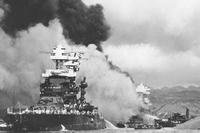The U.S. military has been actively working to remove references to the Confederacy and Confederate leaders in recent years, but that hasn’t always been the case. Just over 50 years after the end of the Civil War, parts of the United States still embraced that troubled past.
By the time the United States entered World War I, veterans from both sides of the Civil War were largely elderly. An 18-year-old who enlisted in 1861 would be 74 years old in 1917, the year the U.S. entered the Great War.
Even so, the U.S. Army wanted to bring something uniquely American to the trenches of Europe. The commander of a particular southern Army unit wanted his men to use the Confederate Rebel Yell to "instill terror in the hearts of the enemy." And they needed the help of Confederate Civil War veterans to do it.

Fort Gordon near Augusta, Georgia, (named for a Confederate general) was originally known as Camp Gordon. During the build up to World War I, the base was in a different location, closer to Atlanta. It was used as a training camp for many of the 2.8 million men who were drafted to serve in the war.
It was first opened in July 1917 and became the training ground for the 82nd Division, later known as the 82nd Airborne Division, when troopers could actually become airborne. The camp operated from 1917 until 1919 and trained many of the conscripts from Georgia.
The man installed to oversee the training of the 82nd Division at Camp Gordon was Gen. Eben Swift, a veteran of the Spanish-American War and the Pancho Villa Expedition and a former director of the Army War College.
Swift wanted to give the Germans a special surprise when the U.S. Army arrived and began fighting in the trenches. He wanted to teach the 82nd Division the "Rebel Yell," a battle cry used by Confederate soldiers as they charged Union lines during the Civil War.

He met with federal judge William T. Newman of Atlanta, a former Confederate soldier who was still in contact with a company of his fellow veterans in Georgia, to teach the battle cry to new soldiers of the 82nd.
"I want my men taught the Rebel Yell for their use in France," Swift told the Times-Dispatch, a Richmond, Virginia, newspaper in 1917. "I met Judge Newman and suggested the Rebel Yell would not sound badly when we meet the Germans. Our boys will use it when they go over the top."
Although there aren't any recordings of the yell in use during the Civil War era, there are recordings of Confederate veterans performing the cry at reunions years later. The video below is from Smithsonian Magazine:
According to the article, Newman did everything he could to assemble the elderly veterans at Camp Gordon to teach the troops the "blood-stirring" battle cry. Union veterans have remarked that the Rebel Yell was effective on the battlefield, saying "if you claim you heard it and weren't scared, that means you never heard it."
Swift expected the use of the Rebel Yell to catch on in the Army once the 82nd began using it, and that the service would adopt the Confederate tradition for the foreseeable future. Instead, it died out with the last of the Confederacy’s remaining veterans.
-- Blake Stilwell can be reached at blake.stilwell@military.com. He can also be found on Twitter @blakestilwell or on Facebook.
Want to Learn More About Military Life?
Whether you're thinking of joining the military, looking for post-military careers or keeping up with military life and benefits, Military.com has you covered. Subscribe to Military.com to have military news, updates and resources delivered directly to your inbox.















